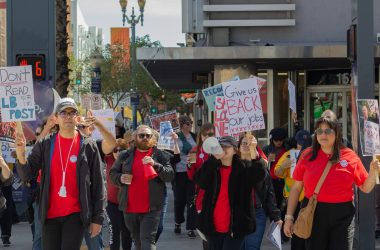International Long Beach State students and alumni continue to experience challenges brought on by the year-long war between Russia and Ukraine.
Feb. 24 marks one year since Russia invaded Ukraine.
Ivan Prokopenko, an international student from Ukraine, explained he still has family in Ukraine and has trouble communicating with them.
“Except for my father who immigrated a few years before the war, all of my friends and relatives remain in Ukraine,” Prokopenko said.
He tries to contact his family and friends daily, but there are often problems with electricity and signal.
As an international student, Prokopenko is exempted from the draft in Ukraine until he finishes his studies.
“Almost all my male friends are involved in the military in one way or another,” Prokopenko said. “My cousin is on the front line, while my friends complete their studies as military officers.”
Prokopenko knew a classmate who died in battle against Russian forces.
As of February, an estimated 200,000 Russian troops have died according to U.S. and European officials.
Former French international student Jules Dalsace who attended CSULB in Fall 2021 said, “It’s difficult to tell a change due to COVID or war.”
Dalsace said France did not experience a large inflation rate because of the war. He believes most changes in his country happened due to COVID-19 rather than the war.
However, many European countries have imposed sanctions on Russian products, causing rising prices and inflation.
Former communication major Beatrix Hartmann, a graduate of 2019, lives near Munich, Germany, where effects of the war have become evident.
“The instability at the beginning of the war also lead to speculation and panic-buying. It affected items such as eggs, flour, milk, potatoes and other staples,” said Hartmann.
Germany and France are both major countries in Europe that relied on gas sourced from Russia.
Petroleum is also one of the most expensive items in Europe. According to Dalsace, petroleum prices went up by 50% during the war. Now the prices are back to pre-war levels.
Currently, it costs around two euros a liter, or about $7.50 per gallon.
Since the invasion, other European countries have changed their energy sources. Germany has switched to using coal energy. France, on the other hand, already used nuclear power before the war.
CSULB political science professor Edgar Kaskla is originally from Estonia, a country bordering Russia, where he still has relatives living in an all-electric house. Kaskla says his relatives’ electric bill cost around 2,000 euros, or $2,000, a month last year.
Estonia was formerly part of the USSR. When it dissolved, Estonia became independent and joined the European Union and NATO later in 2004.
According to Kaskla, since Estonia is now part of the EU and NATO, Estonians feel safer, even though it borders Russia.
If Russia attacked Estonia, it would trigger Article 5, which states that an attack on one is an attack on all. This means that if Russia does attack Estonia, it would trigger all NATO members to go to war against Russia.
Estonia also has the third-highest inflation rate in the EU with food prices in Estonia up 28%. The average inflation on food is about 18.6% in the EU.
The U.S., along with other nations, has been sending supplies to Ukraine to help defend itself from Russia.
Chairman of the Joint Chiefs Gen. Mark Milley said, “Until Putin ends his war of choice, the international community will continue to support Ukraine with the equipment and capability it needs to defend itself.”
On Jan. 31, the Under Secretary of Defense for Policy Colin H. Kahl stated, “[Russia is] running low on artillery. They’re running low on standoff munitions, and they are substituting by sending convicts in human waves into places like Bakhmut and Soledar.”




